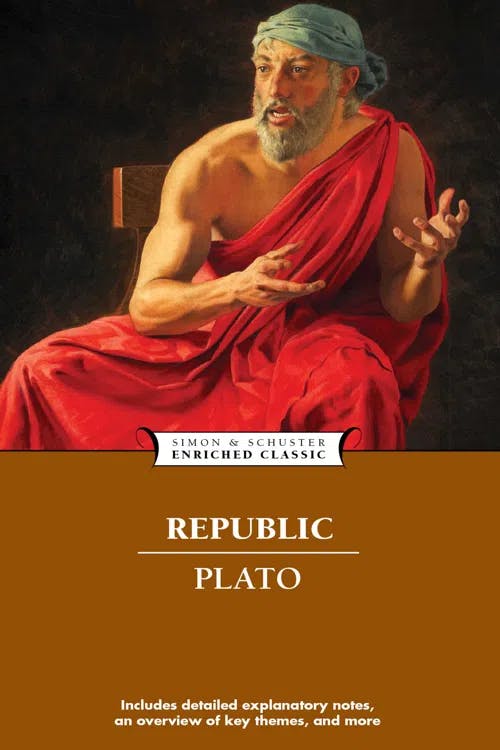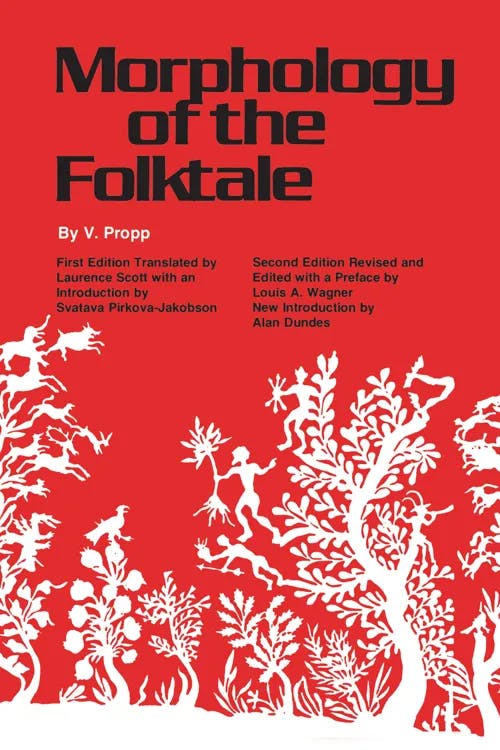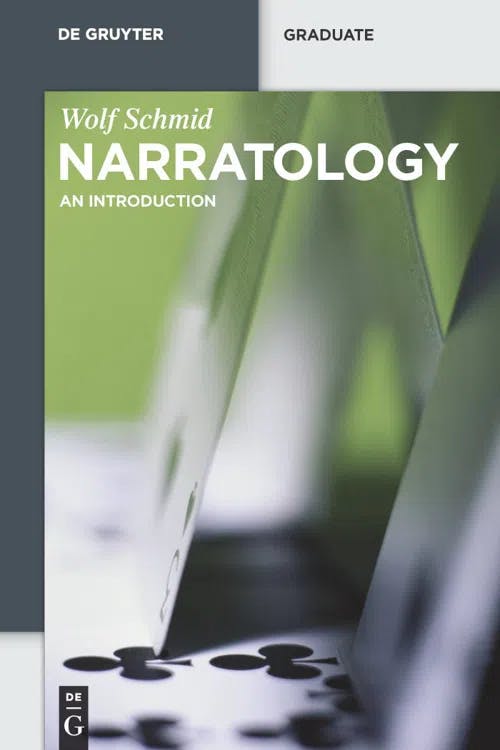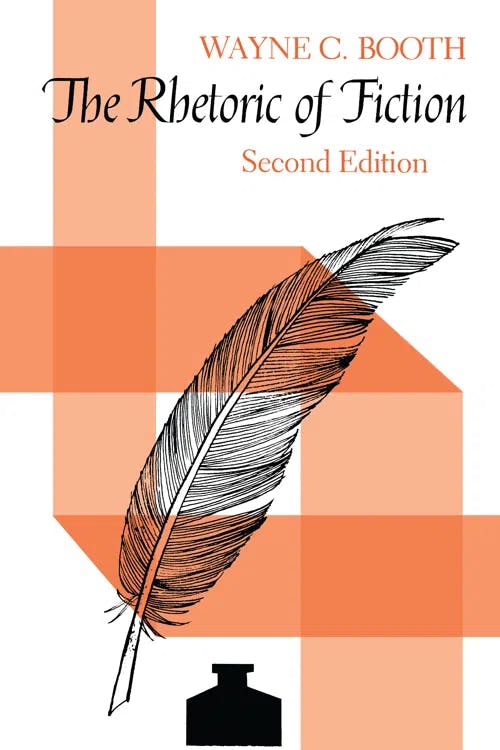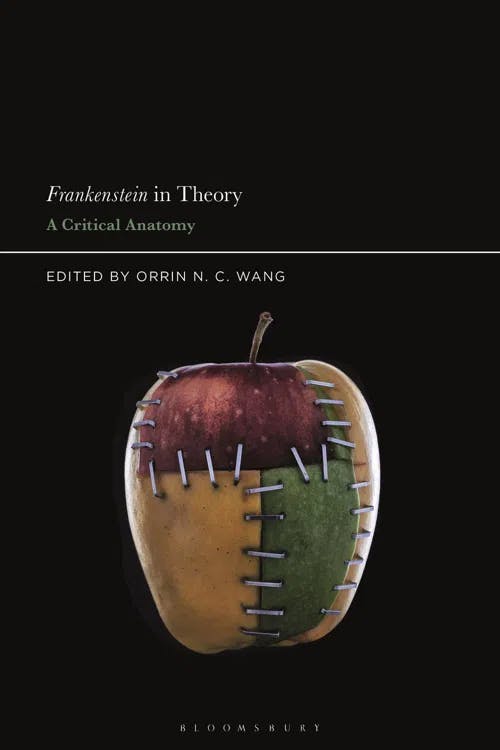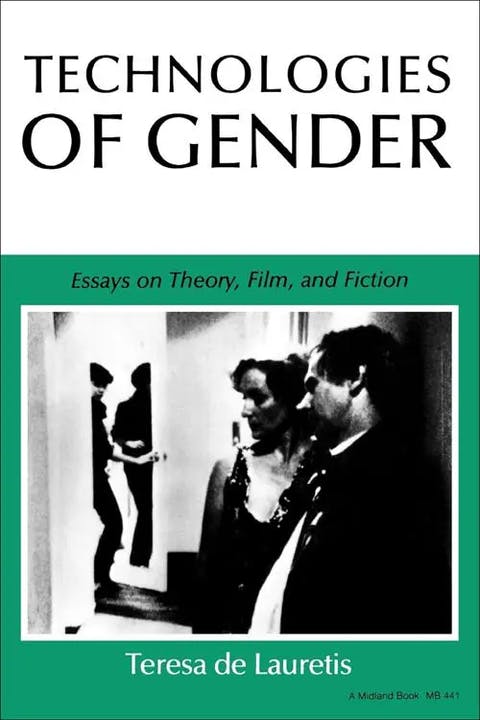What is Narratology?
MSt, Women's, Gender & Sexuality Studies (University of Oxford)
Date Published: 06.07.2023,
Last Updated: 24.01.2024
Share this article
Defining narratology
Narratology is the study of narrative form and function. Tzvetan Todorov coined the term in Grammaire du Décaméron (1969), calling for “la science du récit” (the science of narrative). Describing narratology as a “science” emphasizes its systematic approach. Influenced by semiotics, linguistics, anthropology, and literary studies, narratology breaks down narratives into their essential elements. Traditionally, the field is unconcerned with a work’s context or aesthetics; instead, as Gerald Prince writes in Narratology (1982, [2012]), narratologists decipher “the traits which distinguish narrative from other signifying systems” and propose tools for “the explicit description of narratives and the comprehension of their functioning.”
Jan Christoph Meister argues narratology is best defined as a discipline, “acknowledging narratology’s dual nature as both a theoretical and an application-oriented academic approach to narrative” (“Narratology,” Handbook of Narratology, 2014).
Emerging from structuralism in the 1960s and 1970s, narratology originally attempted to define universal narrative structures and elements. In the 1980s, however, narratology responded to post-structuralist critiques, beginning to address cultural context and reader interpretation. Since then, narratology has become increasingly multi-disciplinary, addressing media from advertisements to video games.
Development of narratology
Although “narratology” is a relatively recent term, the study of narrative dates back to Plato and Aristotle. In The Republic (c. 375 BCE), Plato writes,
all mythology and poetry are a narration of events, either past, present, or to come [...] And narration may be either simple narration or imitation, or a union of the two. (c. 375 BCE, [2016])
Plato
all mythology and poetry are a narration of events, either past, present, or to come [...] And narration may be either simple narration or imitation, or a union of the two. (c. 375 BCE, [2016])
Here, Plato draws a distinction between a story told through a narrator (simple narration) and a story that imitates life (mimesis), like a play.
Aristotle’s Poetics (c. 330 BCE, [2020]) is often considered the foundational work of narratology. For Aristotle, narrative works are based on incidents and events. Focusing on tragedy, he lists a hierarchy of essential elements, with plot (muthos) as the most important. Aristotle’s ideas — like his definition of plot as “an ordered sequence of events” — continue to influence narratology today (c. 330 BCE, [2020]).
Another foundation for narratology is late-nineteenth and early-twentieth century studies of folklore. Vladimir Propp’s Morphology of the Folk Tale (1928, [2010]) attempts to comprehensively catalog fairy tales. Borrowing the word “morphology” from botany, Propp scientifically examines narratives:
it is possible to make an examination of the forms of the tale which will be as exact as the morphology of organic formations. If this cannot be affirmed for the tale as a whole, in its full extent, it can be affirmed in any case for the so-called fairy tales, that is, tales in the strictest sense of the word. (1928, [2010])
Vladimir Propp
it is possible to make an examination of the forms of the tale which will be as exact as the morphology of organic formations. If this cannot be affirmed for the tale as a whole, in its full extent, it can be affirmed in any case for the so-called fairy tales, that is, tales in the strictest sense of the word. (1928, [2010])
Propp examines the essential components and “functions” of fairy tales. His rigorous, empirical approach inspired Russian formalists. This movement — which flourished from 1916 to the late 1920s — aimed to describe literature in terms of form, autonomous from biological and historical influences. Russian formalist Mikhail Bakhtin introduced important literary concepts such as heteroglossia (the belief that each work is in conversation with countless other works), carnivalesque and chronotope (a term used to describe how temporal-spatial relationships are expressed in literature).
Narratology emerged decisively from French structuralism, an intellectual movement lasting roughly from 1966 to 1980. Structuralism proposes that human behavior and culture are dictated by underlying systems. Structural narratology combines elements of Russian formalism and Propp’s Morphology with Ferdinand de Saussure's Course in General Linguistics (1916) — which treats language as a scientific system of signs — and Claude Lévi-Strauss’ structural anthropology. A leading structuralist, Lévi-Strauss approaches myth as high-level language that can be broken into component parts. This desire to identify universal structures is central to narratology’s initial project.
Roland Barthes bridged narratology’s structuralist and post-structuralist periods. Revising models proposed by Propp and Lévi-Strauss, Barthes introduces concepts like narrative levels (see “Key concepts in narratology” below) and argues that narration is signaled by signs of narrativity (e.g., saying “once upon a time”). Barthes writes,
our society takes the greatest pains to conjure away the coding of the narrative situation: [...] epistolary novels, supposedly rediscovered manuscripts, author who met the narrator, films which begin the story before the credits. The reluctance to declare its codes characterizes bourgeois society and the mass culture issuing from it: both demand signs which do not look like signs. (“Introduction to the Structural Analysis of Narratives,” Narratology, 2014)
Edited by Susana Onega and José Àngel García Landa
our society takes the greatest pains to conjure away the coding of the narrative situation: [...] epistolary novels, supposedly rediscovered manuscripts, author who met the narrator, films which begin the story before the credits. The reluctance to declare its codes characterizes bourgeois society and the mass culture issuing from it: both demand signs which do not look like signs. (“Introduction to the Structural Analysis of Narratives,” Narratology, 2014)
Importantly, Barthes differentiates between the author, the implied author, and the narrator. He defines narrative as necessarily communicated to a receiver, an idea that would influence Prince’s concept of the “narratee” (see “Key concepts in narratology” below).
Influenced by structuralism, narratology was initially invested in defining narrative universals. However, as post-structuralism questioned structuralism’s emphasis on fixed binaries and stable systems, narratology evolved. From 1980 to the present, narratology has developed new methodologies.
In Reading for the Plot (1984), excerpted in Narratology (2014), Peter Brooks moves beyond a structuralist account of plot as organization, “a matter of typology or of fixed structures.” For Brooks, plot is “the logic and dynamic of narrative, and narrative itself a form of understanding and explanation,” so plot must take into account intentionality, psychology, and desire (1984, [2014]).
Since the 1980s, narratology has increasingly considered social and cultural factors and, as we explore in the next section, re-evaluated its definitions of “narrative” and “text.”
Defining narrative and text
If narratology is the study of narrative, what exactly is a narrative? The answer is not straightforward. Susana Onega and José Àngel García Landa note that the “conceptual ambivalence of ‘narrative’ is present [...] from the very beginning of the discipline” (Narratology [2014]).
In Narratology (2010), Wolf Schmid discusses two concepts of narrativity. Classical narrative defines narrative by the presence of a mediator, a narrator. Structural narrativity defines a narrative not by how it’s communicated but by what is narrated: narrative texts “contain a temporal structure and represent changes of state” (Schmid, 2010). Onega and García Landa summarize these two definitions: “a work with a narrator” and “a work with a plot” (2014).
Schmid argues that both definitions have shortcomings:
The classical concept restricts narrativity to the domain of verbal communication, covering only those works containing a narrating authority, or mediator [...] while excluding all lyric, dramatic, and cinematic texts. The structuralist concept, on the other hand, can apply to a representation in any medium, but excludes representations whose referents do not have a temporal structure and consequently do not contain any changes of state. (2010)
Wolf Schmid
The classical concept restricts narrativity to the domain of verbal communication, covering only those works containing a narrating authority, or mediator [...] while excluding all lyric, dramatic, and cinematic texts. The structuralist concept, on the other hand, can apply to a representation in any medium, but excludes representations whose referents do not have a temporal structure and consequently do not contain any changes of state. (2010)
To have temporal structure and represent a change of state, a work must represent an event. Acknowledging this need, Prince defines a narrative as “the representation of at least two real or fictive events or situations in a time sequence, neither of which presupposes the other” (emphasis original, 1982, [2012]).
Modern narratology borrows from all these definitions to analyze complex narratives and unorthodox texts. While narratologists still study traditional literature, they increasingly recognize a text as anything made of signs — linguistic, pictorial, gestural, musical, or a combination of these. As Onega and García Landa write,
Any representation involves a point of view, a selection, a perspective on the represented object, criteria of relevance, and, arguably, an implicit theory of reality. Narrative structuring may become most elaborate in literary texts, but narrativization is one of the commonest ways of applying an order and a perspective to experience. (2014)
Narratives are all around us — in novels, movies, TV shows, bedtime stories, video games, TikToks, advertisements, paintings, songs, and more.
Key concepts in narratology
Narratology employs specific terms and concepts; here are the most essential. For more in-depth entries and other concepts, see Handbook of Narratology (2014) and the glossary in An Introduction to Narratology (2009).
Author: The author is the intellectual creator of a text, the real person who composes the work.
Implied author: The implied author is the “author-image evoked by a work and constituted by the stylistic, ideological, and aesthetic properties for which indexical signs can be found in the text” (Schmid, “Implied Author,” Handbook of Narratology, 2014). The implied author arises from the text itself and can be perceived differently by each reader.
Narrator: Distinct from the author or implied author, the narrator is the textually encoded voice through which events, actions, characters, etc. are conveyed. The narrator is a communicative role. The narrator can be, for example, an anonymous, omniscient presence (as in War and Peace [1869]); a character implicated in the narrative’s events (as in The Great Gatsby [1925]); or, as in multi-narrator works (like As I Lay Dying [1930]), a series of consciousnesses.
Reader: The reader experiences the text and helps shape it; the reader is a “decoder, decipherer, interpreter” (Prince, “Reader,” Handbook of Narratology, 2014). Audience-oriented branches of narratology (such as reader-response theory) interrogate texts by asking questions about how readers encounter them.
Implied reader: The implied reader is “the author’s image of the recipient that is fixed and objectified in the text” (Schmid, “Implied Reader,” Handbook of Narratology, 2014). While the author may have a “real” intended reader, this is not the implied reader. Like the implied author, the implied reader is a function of the text, emerging from its signs. As Wayne C. Booth writes,
the reader whom the implied author writes to can be found as much in the text’s silences as in its overt appeals. What the author felt no need to mention tells us who he thinks we’ll be—or hopes we’ll be. (The Rhetoric of Fiction, 1983, [2010])
Wayne C. Booth
the reader whom the implied author writes to can be found as much in the text’s silences as in its overt appeals. What the author felt no need to mention tells us who he thinks we’ll be—or hopes we’ll be. (The Rhetoric of Fiction, 1983, [2010])
Narratee: The term narratee, coined by Prince (see “Introduction to the Study of the Narratee,” reprinted in Narratology [2014]), describes the entity to whom the narrator directs their narration. There are two kinds of narratees: the addressee (the intended recipient) and the receiver (the actual recipient). Like the narrator, the addressee can be implicit or explicit.
Perspective/point of view: These terms describe how the story’s presentation relates to the experience of the narrator/other characters. From whose perspective do we see? Common perspectives in narratives include “first person” (the narrator describes the action through their eyes, e.g., “I rode over the field”) and “third person” (the narrator describes the action as an uninvolved observer, e.g., “Sally rode over the field”). Third-person narration may be omniscient (speaking to the knowledge/experience of all characters) or limited (filtered through the knowledge/experience of a specific character).
Focalization: Focalization was introduced by Gérard Genette in Figures III (1972) as a reformulation of perspective/point of view. Focalization describes how narrative information is selected or restricted based on the knowledge of the narrator and their relationship to other entities. Its core question is “who sees?” Genette proposes three kinds of focalization: zero, internal, and external. In zero focalization, sometimes called the “omniscient narrator,” the narrator says more than any of the characters knows (Narrator > Character). In internal focalization, the narrator says only what a given character knows (Narrator = Character). In external focalization, the narrator says less than the character knows, adopting an objective, detached perspective (Narrator < Character).
Fabula: The term fabula was used by Russian formalists to indicate the essence of a story. The tale of Cinderella may be told in various ways, with different narrators or even different plot points, but the term fabula indicates the story’s essence, the motif, myth, or fable at its heart.
Plot: Plot describes how events and actions are arranged and related based on motivations and consequences. Narratologists conceive of plot in three essential ways:
- Plot is the global, fixed structure of story events, configured from beginning to middle to end.
- Plot is progressively structured as readers perceive and consider the connections between events.
- Plot is intentionally structured by the author to achieve certain effects.
Narrative levels: Narrative levels describe the relationships between narrator, narratee, narrative act, and larger narrative structure. They shift when a narrator changes or when the relationship between the act of narration and the storyworld changes. For example, a novel may be mostly narrated by a single character but feature a long letter in which another character explains events that happened years prior: the narrative level has changed.
Vertical/horizontal narrative changes: Narratologists track narrative changes vertically and horizontally. A vertical change indicates a shift between narrative levels. This shift may be accompanied by a change in narrator (e.g., the primary narrator listens to a “story within a story” told by a different character). A vertical change can also occur when the narrator stays the same, but the narratee changes. During a horizontal change, the narrative level remains consistent, but the narrator or the nature of the narration changes. For example, parallel narrators may operate on the same narrative level, or a narrator may enter a dream state.
Frame/frame narrative: “Frame” or “embedded” narratives operate across multiple narrative levels. Specifically, a “frame” creates a scenario for the act of narration. For example, in the film The Princess Bride (Reiner, 1987), the frame is a grandfather reading a book to his grandson. The frame motivates the telling of the embedded tale. Introductory framing occurs at a work’s beginning to introduce the primary narrative, whereas terminal framing appears at the work’s end (e.g., revealing it was all a dream). Framing can be interspersed throughout, or there can be multiple levels of framing, stories told by characters within stories (as in Ovid’s Metamorphoses [8 CE]). See Chapter 4 of Monika Fludernik’s An Introduction to Narratology (2009) for a discussion of frame narratives, accompanied by diagrams.
Metanarration/Metafiction: The terms metanarration and metafiction indicate moments when a work self-reflectively comments on an act as it accomplishes it. Metanarration describes narration which comments on the act of narrating, while metafiction refers to moments in fiction that reflect on fictionality or the constructedness of language.
In the next section, we’ll apply some of these terms to an analysis of Frankenstein (1818, [2012]).
Case study: narratology and Frankenstein
Looking at Mary Shelley’s Frankenstein, we can see various narratological ideas in action.
Frankenstein’s publication history helps us see the difference between author and implied author. Shelley is Frankenstein’s author, but the novel was initially published anonymously. As readers speculated about the book’s authorship, they likely used their conception of the work’s implied author to make assumptions about its true author. For example, because the text’s narrators are largely male, a reader may interpret the implied author as a man.
Frankenstein operates on several narrative levels. The novel is framed as letters from Captain Walton, a man on an expedition to the North Pole, to his sister. In this outermost narrative level, Walton is the narrator and his sister is the narratee. We shift levels vertically when we enter the story told by Victor Frankenstein (the new narrator) to Robert Walton (the new narratee), which Walton transcribes for his sister. Victor’s lengthy story features other epistolary narrative shifts. For example, Victor’s beloved Elizabeth takes on the role of narrator in a letter to him: “I must tell you a little story that will please, and perhaps amuse you” (Shelley, 1818, [2012]). While Victor narrates most of the novel’s first and third volumes, much of the second volume is narrated by the creature to Victor. At the end of the novel, we return to Walton, and shorter letters from Walton to his sister relate Victor’s end.
Yoon Sun Lee argues that Shelley’s novel uses framing to ask questions about plot, knowledge, and representation. Lee writes,
As a frame tale, Frankenstein proves challenging when it comes to making decisions about the plot’s priorities. This is the case not only because of the complexity and number of narrative levels, but because of the particularly fraught significance the novel assigns to the very idea and the practice of framing. (Yoon Sun Lee, “Finitude, Frames, and the Plot of Frankenstein,” Frankenstein in Theory, 2020)
Edited by Orrin N. C. Wang
As a frame tale, Frankenstein proves challenging when it comes to making decisions about the plot’s priorities. This is the case not only because of the complexity and number of narrative levels, but because of the particularly fraught significance the novel assigns to the very idea and the practice of framing. (Yoon Sun Lee, “Finitude, Frames, and the Plot of Frankenstein,” Frankenstein in Theory, 2020)
Discussing narrative levels, Lee notes that “Shelley’s tales [...] exist side by side, but they also contain each other, nested within” (2020). For Lee, the novel’s plot, represented by the pieced-together creature itself, “arises as much from its layout, its structure, as from the events that make up its stories,” while the use of framing conveys a shift from viewing knowledge as attainable to inaccessibly infinite (2020). Lee’s analysis reveals how narratological concepts can reveal not only a text’s form but also its meaning.
(For more on Frankenstein, you can explore our study guide "Gothic Fiction - Key Elements of Gothic Literature & Film".)
Interdisciplinary and “new” narratologies
In recent decades, narratology has broadened in scope to address various narrative forms and draw upon other disciplines. Here we highlight three areas of growth for narratology since 1980: feminist narratology, narrative approaches to video games, and narrative medicine.
Feminist narratology
Feminist narratology (and queer narratology) examine how sex, gender, and sexuality shape narratives. Emerging with force in 1986 with Robyn R. Warhol’s “Toward a Theory of the Engaging Narrator” and Susan S. Lanser’s “Toward a Feminist Narratology,” feminist narratology challenged narratology’s traditional approach: feminist narratologists argued that classical and structuralist narratology was shaped by gendered assumptions and overlooked how sex, gender, and sexuality influence not only how a reader interacts with a text but also the text’s own form and function.
In Alice Doesn’t (1984) and Technologies of Gender (1987), Teresa de Lauretis draws upon both narratology and feminist theory with a special interest in cinema. De Lauretis reads conventional understandings of narrative structure and plot as gendered, and analyzes how
narrative and narrativity, because of their capacity to inscribe desire and to direct, sustain, or undercut identification [...] are mechanisms [...] to shift the terms of representation, to produce the conditions of representability of another—and gendered—social subject. (1987)
Teresa de Lauretis
narrative and narrativity, because of their capacity to inscribe desire and to direct, sustain, or undercut identification [...] are mechanisms [...] to shift the terms of representation, to produce the conditions of representability of another—and gendered—social subject. (1987)
Lanser’s Fictions of Authority (1992, [2018]) brought feminist narratology to prominence through a wide-ranging study of novels by women from the 1740s to the 1990s and the challenges their narrative voices post to “Western” conventions. Lanser argues that
both narrative structures and women’s writing are determined not by essential properties or isolated aesthetic imperatives but by complex and changing conventions that are themselves produced in and by the relations of power that implicate writer, reader, and text. In modern Western societies [...] these constituents of power must include, at the very least, race, gender, class, nationality, education, sexuality and marital status, interacting with and within a given social formation. (1992, [2018])
Susan Sniader Lanser
both narrative structures and women’s writing are determined not by essential properties or isolated aesthetic imperatives but by complex and changing conventions that are themselves produced in and by the relations of power that implicate writer, reader, and text. In modern Western societies [...] these constituents of power must include, at the very least, race, gender, class, nationality, education, sexuality and marital status, interacting with and within a given social formation. (1992, [2018])
For more on feminist narratology, see “Gender and Narrative” in Handbook of Narratology (2014), Ambiguous Discourse (2000), and Literary and Linguistic Approaches to Feminist Narratology (2006).
Approaching video games: ludology vs. narratology
As video games have grown in complexity and gained scholarly attention, the question of narrativity in these games arose, sparking the Ludology vs. Narratology Debate. Some scholars denied the narrative potential of computer games altogether, while others sought to directly apply narratological principles to this new medium. Those championing ludology (the study of games) argued that applying a narratological approach positioned video games as derivatives of literature and film, and overlooked the specificities of their status as games. Britta Neitzel argues that both positions — treating games as simple narratives or denying the similarities between narratives and games — are too narrow. She writes,
Common to both positions is that they one-sidedly isolate one single dimension to the exclusion of all others, an approach which fails to acknowledge the specifics of the computer—namely, the fact that the computer is a hybrid medium that integrates various forms and media—and in so doing dissolves distinctions between them. (“Narrativity of Computer Games,” Handbook of Narratology, 2014)
In Understanding Video Games (2019), Simon Egenfeldt-Nielsen, Jonas Heide Smith, and Susana Pajares Tosca point out that a narrative or story of some kind is almost always present in video games but that literary theorists and video game designers often use the term narrative differently. Egenfeldt-Nielsen, Smith, and Tosca write,
Much of the scholarly discussion around narrative and video games deals with the perceived difficulty of combining a playing experience that feels free with the necessary constraints of a narrative structure. In other words, the problem of letting players act freely while ensuring that their actions produce an interesting story. (2007, [2019])
Simon Egenfeldt-Nielsen, Jonas Heide Smith, and Susana Pajares Tosca
Much of the scholarly discussion around narrative and video games deals with the perceived difficulty of combining a playing experience that feels free with the necessary constraints of a narrative structure. In other words, the problem of letting players act freely while ensuring that their actions produce an interesting story. (2007, [2019])
For more on narrativity and video games, see also The Meaning of Video Games (2008) and Video Games and Storytelling (2015).
Narratives and medicine
Narrative medicine is a growing interdisciplinary field of research. While narratology and medicine may at first seem disparate, stories frequent medical settings. The two most relevant medical narratives are the case history (the physician’s account of the patient’s condition) and the illness narrative (the sick person’s account of their own experience).
The illness narrative is of particular interest to scholars in the medical humanities and practitioners aiming to develop patient-focused, individualized practices. In Illness as Narrative (2012), Ann Jurecic challenges literary theorists’ unwillingness to treat illness narratives as literature. Jurecic explores “how writers and readers use narratives of illness to make meaning of the experiences of living at risk, in prognosis, and in pain” and “how narratives of illness invite reflection about the purpose and future of literature, the arts, and literary criticism” (2012).
Understanding medical experiences through the language of narrative can not only provide tools for understanding, communicating, and responding to illness but also provoke us to reconsider assumptions regarding the narrative trajectory we ascribe to illness, the roles we ascribe to ill people, and the function of illness in the stories we tell. For more on narrative and medicine, see The Wounded Storyteller (1995, [2013]), Stories Matter (2004), and Psychoanalysis and Narrative Medicine (2008).
As narratology continues to address new forms of media and intersect with other disciplines, we will gain new insights into the stories and forms of storytelling that structure our world.
Further reading on Perlego
Anatomy of Criticism: Four Essays (1957, [2020]) by Northrop Fry
A Grammar of Stories (1973, [2012]) by Gerald Prince
On Literature (2005) by Umberto Eco
Body Work: Objects of Desire in Modern Narrative (1993, [2009]) by Peter Brooks
Current Trends in Narratology (2011), edited by Greta Olson
Letting Stories Breathe: A Socio-Narratology (2010) by Arthur W. Frank
Neverending Stories: Toward a Critical Narratology (1991, [2014]), edited by Ann Fehn, Ingeborg Hoesterey, and Maria Tatar
What is narratology in simple terms?
What are examples of narratology?
What are the best books on narratology?
Bibliography
Aristotle (2020) Poetics. Nick Hern Books. Available at: https://www.perlego.com/book/1421171/poetics-pdf
Barthes, R. (2014) “Introduction to the Structural Analysis of Narratives,” in Onega, S. and Landa, J. A. G. (eds.) Narratology: An Introduction. Routledge. Available at: https://www.perlego.com/book/1555786/narratology-an-introduction-pdf
Booth, W. C. (2010) The Rhetoric of Fiction. 2nd edn. University of Chicago Press. Available at: https://www.perlego.com/book/1852586/the-rhetoric-of-fiction-pdf
Brooks, P. (2014) “Reading for the Plot,” in Onega, S. and Landa, J. A. G. (eds.) Narratology: An Introduction. Routledge. Available at: https://www.perlego.com/book/1555786/narratology-an-introduction-pdf
Charon, R. and Montello, M. (eds.) (2004) Stories Matter: The Role of Narrative in Medical Ethics. Taylor and Francis. Available at: https://www.perlego.com/book/1611138/stories-matter-the-role-of-narrative-in-medical-ethics-pdf
De Lauretis, T. (1984) Alice Doesn't: Feminism, Semiotics, Cinema. Indiana University Press.
De Lauretis, T. (1987) Technologies of Gender: Essays on Theory, Film, and Fiction. Indiana University Press. Available at: https://www.perlego.com/book/569281/technologies-of-gender-essays-on-theory-film-and-fiction-pdf
Egenfeldt-Nielsen, S., Smith, J. H. and Tosca, S. P. (2019) Understanding Video Games: The Essential Introduction. 4th edn. Taylor and Francis. Available at: https://www.perlego.com/book/1598204/understanding-video-games-the-essential-introduction-pdf
Faulker, W. (1991) As I Lay Dying. Vintage.
Fitzgerald, F. S. (2003) The Great Gatsby. Scribner. Available at: https://www.perlego.com/book/780773/the-great-gatsby-pdf
Fludernik, M. (2009) An Introduction to Narratology. Translated by P. Häusler-Greenfield and M. Fludernik. Taylor and Francis. Available at: https://www.perlego.com/book/1609697/an-introduction-to-narratology-pdf
Frank, A. (2013) The Wounded Storyteller: Body, Illness & Ethics. 2nd edn. The University of Chicago Press. Available at: https://www.perlego.com/book/1850618/the-wounded-storyteller-body-illness-and-ethics-second-edition-pdf
Genette, G. (1972) Figures III. Éditions du Seuil.
Hühn, P. et al. (eds.) (2014) Handbook of Narratology. 2nd edn. De Gruyter. Available at: https://www.perlego.com/book/607618/handbook-of-narratology-pdf
Jones, S. (2008) The Meaning of Video Games: Gaming and Textual Strategies. Taylor and Francis. Available at: https://www.perlego.com/book/1606666/the-meaning-of-video-games-gaming-and-textual-strategies-pdf
Jurecic, A. (2012) Illness as Narrative. University of Pittsburgh Press. Available at: https://www.perlego.com/book/3061378/illness-as-narrative-pdf
Kindt, T. and Müller, H.-H. (eds.) (2008) What Is Narratology? Questions and Answers Regarding the Status of a Theory. De Gruyter. Available at: https://www.perlego.com/book/651621/what-is-narratology-pdf
Kukkonen, K. (2014) “Plot,” in Hühn, P. et al. (eds.) Handbook of Narratology. 2nd edn. De Gruyter. Available at: https://www.perlego.com/book/607618/handbook-of-narratology-pdf
Lanser, S. S. (1986). “Toward a Feminist Narratology,” Style, vol. 20, no. 3, pp. 341-363. Available at: http://www.jstor.org/stable/42945612
Lanser, S. S. (2014) “Gender and Narrative,” in Hühn, P. et al. (eds.) Handbook of Narratology. 2nd edn. De Gruyter. Available at: https://www.perlego.com/book/607618/handbook-of-narratology-pdf
Lanser, S. S. (2018) Fictions of Authority: Women Writers and Narrative Voice. Cornell University Press. Available at: https://www.perlego.com/book/566034/fictions-of-authority-women-writers-and-narrative-voice-pdf
Lee, Y. S. (2020) “Finitude, Frame, and the Plot of Frankenstein,” in Wang, O. (ed.) Frankenstein in Theory: A Critical Anatomy. Bloomsbury Publishing. Available at: https://www.perlego.com/book/2035903/frankenstein-in-theory-a-critical-anatomy-pdf
Lévi-Strauss, C. (2017) “The Structural Study of Myth,” in Rivkin, J. and Ryan, M. (ed.) Literary Theory: An Anthology. 3rd edn. Wiley. Available at: https://www.perlego.com/book/992490/literary-theory-an-anthology-pdf
Mezei, K. (ed.) (2000) Ambiguous Discourse: Feminist Narratology and British Women Writers. The University of North Carolina Press. Available at: https://www.perlego.com/book/538045/ambiguous-discourse-feminist-narratology-and-british-women-writers-pdf
Mukherjee, S. (2015) Video Games and Storytelling: Reading Games and Playing Books. Palgrave Macmillan UK. Available at: https://www.perlego.com/book/3487216/video-games-and-storytelling-reading-games-and-playing-books-pdf
Neitzel, B. (2014) “Narrativity of Computer Games,” in Hühn, P. et al. (eds.) Handbook of Narratology. 2nd edn. De Gruyter. Available at: https://www.perlego.com/book/607618/handbook-of-narratology-pdf
Onega, S. and Landa, J. A. G. (eds.) (2014) Narratology: An Introduction. Routledge. Available at: https://www.perlego.com/book/1555786/narratology-an-introduction-pdf
Ovid (2020) Metamorphoses. Open Road Media. Available at: https://www.perlego.com/book/2448806/metamorphoses-pdf
Page, R. (2006) Literary and Linguistic Approaches to Feminist Narratology. Palgrave Macmillan UK. Available at: https://www.perlego.com/book/3503761/literary-and-linguistic-approaches-to-feminist-narratology-pdf
Plato (2016) Republic. Simon & Schuster. Available at: https://www.perlego.com/book/778449/republic-pdf
Prince, G. (2012) Narratology: The Form and Functioning of Narrative. De Gruyter. Available at: https://www.perlego.com/book/654020/narratology-pdf
Prince, G. (2014) “Introduction to the Study of the Narattee,” in Onega, S. and Landa, J. A. G. (eds.) Narratology: An Introduction. Routledge. Available at: https://www.perlego.com/book/1555786/narratology-an-introduction-pdf
Prince, G. (2014) “Reader,” in Hühn, P. et al. (eds.) Handbook of Narratology. 2nd edn. De Gruyter. Available at: https://www.perlego.com/book/607618/handbook-of-narratology-pdf
Propp, V. (2010) Morphology of the Folk Tale. Translated by L. Scott. 2nd edn. University of Texas Press. Available at: https://www.perlego.com/book/3273841/morphology-of-the-folk-tale-pdf
Rudnytsky, P. and Charon, R. (eds.) (2008) Psychoanalysis and Narrative Medicine. State University of New York Press. Available at: https://www.perlego.com/book/2672751/psychoanalysis-and-narrative-medicine-pdf
Saussure, F. (2011) Course in General Linguistics. Translated by W. Baskin. Columbia University Press. Available at: https://www.perlego.com/book/774968/course-in-general-linguistics-pdf
Schmid, W. (2010) Narratology: An Introduction. De Gruyter. Available at: https://www.perlego.com/book/652697/narratology-pdf
Schmid, W. (2014) “Implied Reader,” in Hühn, P. et al. (eds.) Handbook of Narratology. 2nd edn. De Gruyter. Available at: https://www.perlego.com/book/607618/handbook-of-narratology-pdf
Shelley, M. (2012) Frankenstein; or, the Modern Prometheus. 3rd edn. Broadview Press. Available at: https://www.perlego.com/book/2029915/frankenstein-third-edition-pdf
The Princess Bride (1987) Directed by Rob Reiner. Available on Disney+.
Todorov, T. (1969) Grammaire du Décaméron. Mouton.
Tolstoy, L. (2020) War and Peace. Read & Co. Classics.
Warhol, R. R. (1986). “Toward a Theory of the Engaging Narrator: Earnest Interventions in Gaskell, Stowe, and Eliot,” PMLA, vol. 101, no. 5, pp. 811-818. Available at: https://doi.org/10.2307/462357
MSt, Women's, Gender & Sexuality Studies (University of Oxford)
Paige Elizabeth Allen has a Master’s degree in Women’s, Gender, and Sexuality Studies from the University of Oxford and a Bachelor’s degree in English from Princeton University. Her research interests include monstrosity, the Gothic tradition, illness in literature and culture, and musical theatre. Her dissertation examined sentient haunted houses through the lenses of posthumanism and queer theory.

